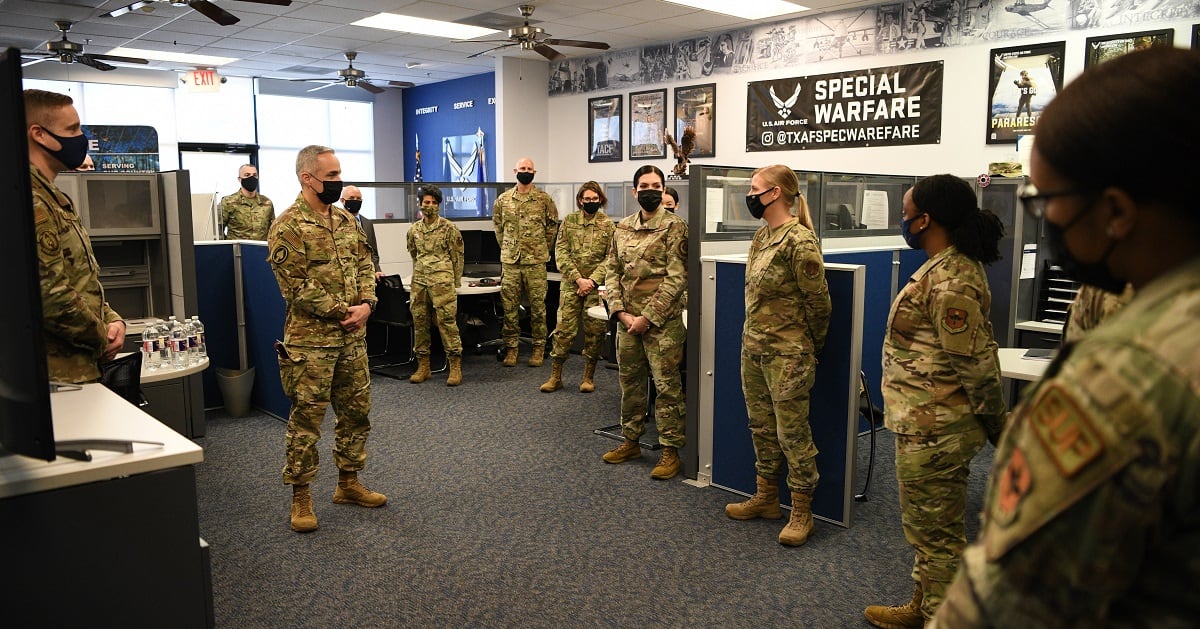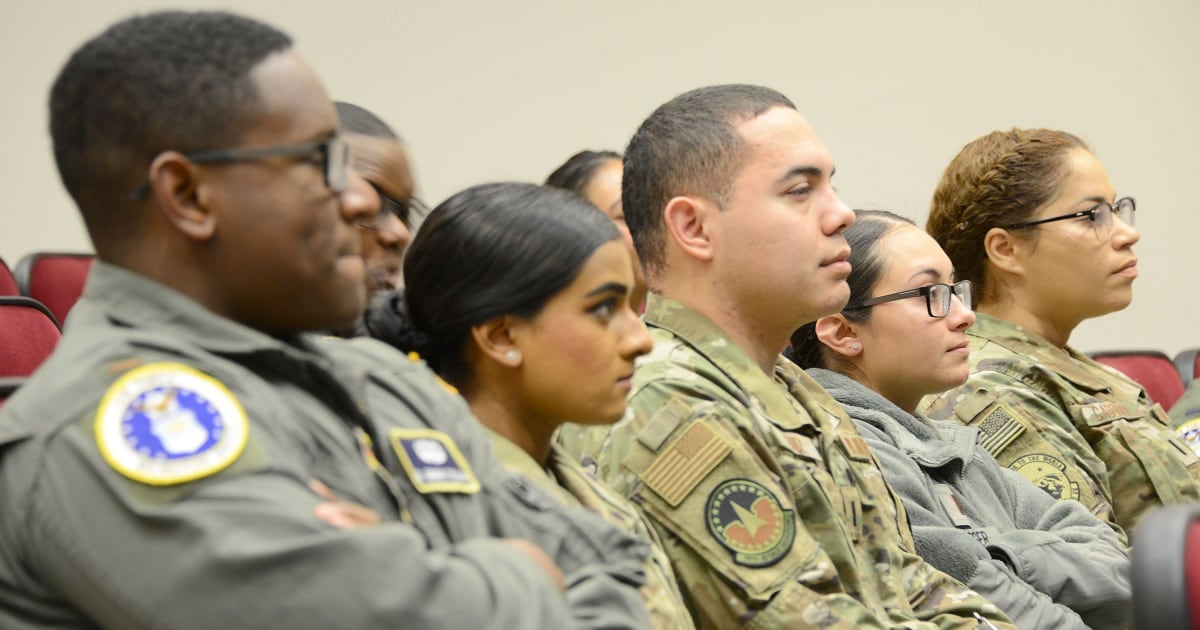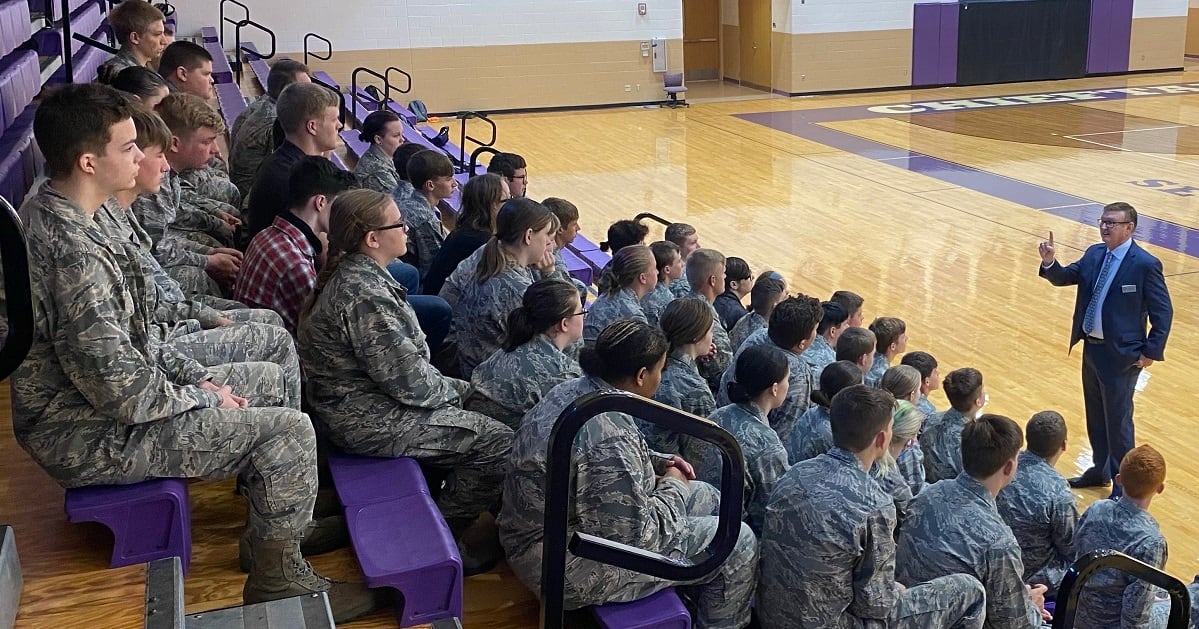The Air Force is on track to meet its 2022 recruitment goal by Sept. 30, but warns it’s limping across the finish line with less cushion than it’d like.
As of Sept. 15, the active duty Air Force had brought in more than 25,000 new enlisted airmen, or about 97% of its goal of 26,151 people.
While the Air Force expects to close the gap in the final weeks of the fiscal year, it typically wants 25% more recruits than needed to fill its open spots. That gives the service some wiggle room in case people drop out of training or if its workforce suddenly needs a boost.
This year, it projects it will have a buffer of just 10% — about a month’s worth of recruits instead of the optimal three.
“We’ll be landing on fumes,” Air Force Recruiting Service boss Maj. Gen. Ed Thomas told Air Force Times in a recent interview.
Officials point to the hot job market, pandemic-era ripple effects, the obesity epidemic and disinterest in military service among younger Americans as the main culprits behind dwindling enlisted recruitment.
The Pentagon claims that three-fourths of Americans ages 17 to 24 are too overweight to join, or would need waivers for other medical issues or criminal histories. One in 10 would consider pursuing military service at all.
Though those often-repeated statistics focus on the portion of the U.S. that is historically most likely to enlist, they ignore millions more Americans who can join the Air Force until age 40.
Some say the military is overly preoccupied with eligibility and propensity data, and use it as a scapegoat to avoid hard discussions about changing those benchmarks and other factors.
“The military needs to take as broad a view [as] possible of who can serve, what are the qualifications and how can we work to allow as many people to serve as possible, while not compromising on the quality of the people that join the services,” said Thomas Spoehr, head of the defense program at the Heritage Foundation.
“This recruiting crisis will cause the leaders to step back and take a long look at our processes, qualifications and standards,” he said.
Much ado about standards
The military is trying to convince people to join its ranks after two decades of increasingly unpopular wars in Afghanistan, Iraq and Syria that — at least initially — drove a spike in recruitment among those eager to serve their country.
A 2011 Pew Research Center study found 33% of Americans ages 18-29 had an immediate family member in uniform, compared to more than 75% of those over 50 — limiting their understanding of modern military life.
Today’s workforce is more transient than in decades past, and struggles with more student debt, the rising cost of living and a volatile housing market. And military families, a typically steadfast source of new members, are turning to other pursuits.
Against that backdrop, the Air Force says it’s having one of the toughest recruiting stretches of the past quarter-century.

“The big question culturally centers around the tension between expanding the pool of eligible candidates without lowering standards,” said Katherine Kuzminski, a military personnel expert at the Center for a New American Security.
Across the active duty Air Force, the Air National Guard and Air Force Reserve, the service brings in around 50,000 recruits each year.
Every year, the Air Force sets its personnel goals based on current retention trends and which career fields are understaffed. Then, it sets out to find people whose skills, character and even home lives meet the Air Force’s own set of standards.
For example, Thomas pointed to a decision to do away with a ban on small hand tattoos, which he said ruled out about 1,500 potential recruits last year, and to the Air Force’s evolving stance on single parents. In 2015, its policy changed to allow unmarried, single parents with custody of up to three children under the age of 18 to enlist.
“We’ve adapted to societal norms,” Thomas said. “We’ve adapted to the trends in society, to the demographics.”
During the COVID-era retention boom two years ago, Thomas said, the service could afford to turn away otherwise qualified people who ran afoul of a single standard, including for issues that can be waived. The service is now combing through those rules to ensure it’s not sacrificing too much quantity for quality.
Debate continues over whether factors like someone’s height-to-weight ratio should disqualify them from service altogether, when they could still pass fitness tests or may be well-suited for a desk job in a field like finance or acquisition. The same issue comes up when discussing potential disqualification for common conditions like diabetes, endometriosis and attention-deficit/hyperactivity disorder.
“The normalization of therapy and increased screening for potential issues like ADHD over the last 20 years means that current potential recruits may face ineligibility for military service for conditions or challenges that existed in previous generations, but weren’t documented,” Kuzminski said.
Naysayers argue that allowing people with conditions that may make them nondeployable in a crisis, regardless of their job, would weaken the Air Force.
“We have no intent to lower standards,” Thomas said. “We need to continue to bring in a very high-quality airman.”
Not just for teenagers
While most Air Force recruits are younger than 25, in part because of the service’s focus on that demographic, the service has to make up for lost time in wooing older millennials.
The active duty Air Force didn’t allow people between the ages of 27 and 39 to enlist until 2014. That puts millennials — those between ages 25 and 41 this year — squarely in the Air Force’s recruiting crosshairs.
Younger workers are more likely than previous generations to work at multiple places over the course of their careers, as well as to switch careers altogether. And following the past two years’ “Great Resignation,” in which nearly 50 million Americans quit their jobs to look for better pay, more flexibility and a greater sense of purpose, some millennials could turn to the military as an option they may have not considered before.

Enlisting later in life has grown increasingly popular since the policy changed, but those airmen are still in the minority. Another lesser-known option is direct commissioning, which can bring in mid-career workers with advanced degrees to replace officers who begin leaving after five years or so.
“The services should not stop trying to recruit Americans when they turn 24 … although it is rare to get anybody even in their late 20s,” Spoehr said. “In today’s environment, they shouldn’t overlook anyone.”
Spoehr, who commanded basic training units during nearly 40 years in the Army, argues that military service is largely a “young person’s game.”
“The long hours and physical training do wear on older people,” he said.
In a study of Army recruitment, however, the federally funded think tank Rand Corp. found that older recruits dropped out of basic training more often, but those who stuck it out performed better than younger soldiers and stayed in the service longer.
“The old mentality was that older recruits tended to be ‘market failures’ — people who didn’t make the cut in college or the civilian market,” said Kuzminski, who worked on the study released earlier this year. “Many of them had really thought through the decision more deeply before signing on, and were driven by both mission and predictability.”
Military advertising doesn’t often showcase the variety of jobs an airman can have throughout their career, which can appeal to people who may want to explore multiple options, who may not like the available jobs a recruiter pitches, or aren’t interested in specialty skills like flying.
Nor do ads often portray airmen’s families or hobbies, helping to fuel misunderstandings about how troops are allowed to spend their free time. For instance, just two of the 90 photos and videos posted on the official Air Force Instagram account since May have portrayed family, and none show off-duty life.
Two new ad campaigns for the Guard and Reserve are trying to bridge that gap.
Not everyone is drawn to the machismo of an ad like “Own the Sky,” which began airing in theaters ahead of “Top Gun: Maverick,” Thomas said. So instead of adrenaline-pumping airborne maneuvers, the ads for part-time airmen focus on off-duty time with family and in school.

“All the analytics and all the thought we put behind our ad campaign are to be able to throw a wide net, to be able to attract a very diverse population and people who … are motivated differently,” he said.
The Air Force’s legacy and social media advertising largely targets 17- to 24-year-olds, and can be tweaked to show up in the feeds of a slightly older audience. But it’s a recruiter’s job, not an ad’s, to make sure people understand the full scope of military benefits, Thomas said.
Many people are aware that military service can earn them a free college education. But older prospects may be more interested in Department of Veterans Affairs loans that make homeownership more accessible and affordable, as well as free health care.
“When you’re talking about everything from job skills, to travel to training to education to retirement, depending on who the applicant is, some of those things a recruiter will emphasize more than others,” Thomas said.
Health records creating new hurdle
The Pentagon’s rocky rollout of MHS Genesis, a new electronic health record system designed to improve continuity of care during and after someone’s military service, has “challenged our recruiting system in a particularly tough year,” Thomas acknowledged.
Genesis aims to compile disparate health records in one place for easier access to a more complete medical history. But not everyone has information readily available to put into the system, dragging out the application process while MEPS, recruiters, and prospective airmen hash out those details.
“Medical information may be discovered that can lead to more applicants requiring a waiver or being disqualified for military service,” Air Force recruiting spokesperson Chrissy Cuttita said in February.
When asked about complaints that applicants are being turned away for reasons like a vitamin deficiency or a previous inhaler prescription that may not have surfaced before, Cuttita said the service’s goal is to root out the “true medical risk” someone could face once in the Air Force.
“Applicants are not disqualified for medications per se, but for the condition that the medication is typically used to treat,” she said. “Also, a prescription history should match what the applicant claimed on their medical history.”
Enlistment physicals have also been delayed while doctors learn the new software, she said.
Thomas described Genesis as a “necessary contributor” to lower recruitment because centralizing electronic health records is “absolutely the right way ahead.”
“It’s something we need to be able to make successful and we will, but it’s a challenge in the meantime,” he said.
THC-positive no longer disqualifying
More applicants are testing positive for THC, the active ingredient in marijuana, at Military Entrance Processing Stations as a growing list of states legalize weed, Thomas said. That typically gets someone permanently banned from joining the Air Force or Space Force.
To address that hurdle, the Air Force Recruiting Service is working on a new policy to waive positive tests in certain situations. If the person is otherwise qualified to serve and the Air Force believes they will act in good faith and forgo cannabis once in the service, Thomas said those would be grounds for a waiver.

“We have to be realistic today,” Thomas said. “We need to exercise common sense.”
Nathalie Grogan, another researcher at CNAS, said adjusting the rules on marijuana could play a role in opening the door to as much as one-third of young American men who may have disqualifying past criminal conduct.
The military services have little control over rules related to illegal substances, particularly in cases like marijuana where the drug can be legal at the state level but not federal.
“Over-policing of growing minority populations and some states’ legalization of marijuana may be leading to an untenable trajectory if the standards remain unchanged,” Grogan said.
Drug sobriety requirements are one piece of a larger conversation on how the communities of color that are disproportionately impacted by uneven law enforcement and sentencing, and recent criminal justice reforms to address those disparities, factor into military recruitment.
“The military now bars from service most candidates with a significant criminal record or documented history of drug use. At the same time, arrests and drug use are increasing among American youth,” Grogan said. “Arrest rates are higher in low-income communities and communities of color.”
Black people are more likely to be arrested for marijuana possession than white people in every state, one factor that further complicates the military’s difficulties in recruiting a force that looks like America.
For a more modern approach to conduct waivers, Grogan argues the military should look at people’s social standing more holistically, including their criminal background and drug use. She also said the services can do more to recruit young women, who are less likely to have a criminal record than men.
Still, Kuzminski argues that screening applicants for bad behavior is better in the long run, noting that people who receive waivers for past misconduct are more likely to run afoul of rules during their service.
The military is more concerned with crimes committed than sentences received, and many convictions can be waived, Spoehr added.
“The ones that cannot be waived typically involve felonies and violence: aggravated assault, burglary, manslaughter, robbery,” he said. “I think, for good reason, people with those types [of] records are probably not suited to military service.”
Give it time
It’s too early to tell how recent policy changes within each service — like those that affect military family planning and women’s opportunities to serve, overhaul sexual assault prosecutions, and allow cadets with children to enroll at U.S. military academies — could affect recruitment.
In the meantime, experts and service members alike say the Air Force needs to stop relying on enlistment bonuses to hook people. Use that money to educate the public, build a savvier social media presence or help airmen, they said.
Kuzminski touted the Army’s new preparation course for those who fall short of academic or physical requirements as a model for the other services.
“It promises to expand the number of new recruits from the pool of individuals who are already interested in service but might otherwise be sidelined, and does so without having to reduce standards,” she said.
Certain improvements can start with the Air Force Recruiting Service itself, too.

Some airmen have talked openly about their struggles with finding a recruiter who knows how to help them join a particular career field, like health care, or attempts to fight a medical misdiagnosis that kept them from enlisting. Others say they were given incorrect information about what waivers were available.
Asked whether that speaks to a need for better recruiter training, Thomas said they’re exceptions to the rule.
“We do have those issues, and we work through them,” he said. “Occasionally, we do have some training issues. But all in all, our recruiters are well prepared to be able to walk them through … all of the information about each individual career field.”
Rachel Cohen is the editor of Air Force Times. She joined the publication as its senior reporter in March 2021. Her work has appeared in the Washington Post, the Frederick News-Post (Md.), Air and Space Forces Magazine, Inside Defense, Inside Health Policy and elsewhere.




